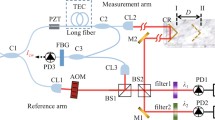Abstract
The sensitivities of heterodyne and direct-detection systems at CO2 laser wavelengths are compared to illuminate the design principles involved. It is shown that destruction of the temporal coherence of scattered radiation is a significant effect when heterodyne systems are used on targets with internal motion. The complete system and the results obtained are then described. The compact optics head contains a waveguide laser, an acousto-optic modulator and SAW chirp devices; it has 45 mm diameter transmit and receive apertures. Whem many returns are integrated, ranges of several kilometres are obtained off natural targets with an accuracy of 10 m. From the Doppler shift off a moving target, radial velocity can be determined simultaneously with the range when an up-chirp/down-chirp technique is used; an accuracy of better than 1 m s−1 is demonstrated.
Similar content being viewed by others
References
M. J. Taylor, P. H. Davies, D. W. Brown, W. F. Woods, I. D. Bell andC. J. Kennedy,Appl. Optics 17 (1978) 885–9.
M. C. Teich,Proc. IEEE 56 (1968) 37–46.
R. A. Brandwie andW. C. Davies,Appl. Opt. 12 (1972) 1526–33.
R. H. Kingston andL. J. Sullivan,Proc. Soc. Photo. Opt. Instrum. Eng. 69 (1975) 10–3.
J. M. Cruikshank,Appl. Optics 18 (1979) 290–3.
A. J. Hughes, J. O'Shaughnessy andE. R. Pike,IEEE J. Quant. Elect. QE-8 (1972) 909–10.
P. M. Woodward, ‘Probability and Information Theory with Applications to Radar’ (Pergamon Press, London, 1953).
C. E. Cook andM. V. Bernfeld, ‘Radar Signals: an Introduction to Theory and Application’ (Academic Press, New York, 1967).
M. I. Skolnik, ‘Introduction to Radar Systems’ (McGraw-Hill, New York, 1967).
C. J. Oliver,Infrared Phys. 18 (1978) 303–7.
Idem, IEEE Trans. Aerospace Elect. Syst. AES-15 (1979) 306–24.
S. Stein andJ. J. Jones, ‘Modern Communications Principles’ (McGraw-Hill, New York, 1967).
M. Born andE. Wolf, ‘Principles of Optics’ 3rd (revised) edn, (Pergamon, Oxford, 1965) p. 468.
D. R. Hall, R. M. Jenkins andE. K. Gorton,J. Phys. D: Appl. Phys. 11 (1978) 859–69.
D. R. Hall, P. H. Cross, R. M. Jenkins andG. K. Gorton,ibid 10 (1977) 1–6.
B. S. Collins, K. F. Hulme andN. A. Lowde,Opt. Quant. Elect. 12 (1980) 419–26.
S. C. Cohen,Appl. Optics 14 (1975) 1953–9.
G. Parry, RSRE, private communication.
L. V. Blake, ‘A Guide to Basic Pulse-Radar Maximum Range Calculations Part 1’NRL Report 6930, Naval Research Lab, Washington, December (1969) (AD-701-321).
L. F. Fehlner, ‘Marcum and Swerling's Data on Target Detection by a Pulsed Radar’John Hopkins University Applied Physics Laboratory Report, TG 451, July (1962) (AD-602-121).
Author information
Authors and Affiliations
Rights and permissions
About this article
Cite this article
Hulme, K.F., Collins, B.S., Constant, G.D. et al. A CO2 laser rangefinder using heterodyne detection and chirp pulse compression. Opt Quant Electron 13, 35–45 (1981). https://doi.org/10.1007/BF00620028
Received:
Revised:
Issue Date:
DOI: https://doi.org/10.1007/BF00620028




